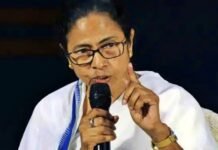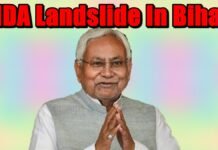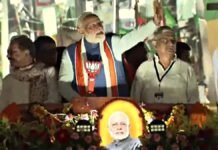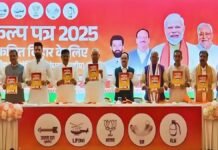
Key Points
- Voting Details: Polling across 122 constituencies at 45,399 polling stations from 7 AM to 5 PM on November 11, 2025
- Voter Strength: Over 3.7 crore eligible voters to decide fate of 1,302 candidates
- Key Ministers: 12 state ministers including Renu Devi, Tarkishore Prasad, and senior BJP-JD(U) leaders in fray
- Phase 1 Record: First phase recorded historic 65.08% turnout, highest ever in Bihar elections
- Security Deployment: Over 4 lakh security personnel deployed across the state
- Exit Polls: To be released after 6:30 PM on November 11 following voting conclusion
- Results Date: Vote counting scheduled for November 14, 2025
Patna: The second phase of Bihar Assembly elections 2025 covers 122 constituencies spread across 20 districts of the state, with a particular focus on the strategically important Seemanchal region and Nepal border areas. The districts going to polls include West Champaran, East Champaran, Sitamarhi, Shivhar, Madhubani, Supaul, Araria, Kishanganj, Purnia, Katihar, Bhagalpur, Banka, Jamui, Nawada, Gaya, Aurangabad, Jehanabad, Arwal, Kaimur, and Rohtas.
The Election Commission identified several sensitive constituencies where special voting arrangements have been made. In the Imamganj Assembly constituency, polling is scheduled until 3 PM at seven highly sensitive booths and until 4 PM at 354 booths, while in Bodh Gaya constituency, voting continues until 4 PM at 200 booths and until 5 PM at 106 booths. All booths in Chainpur, Rajauli, Govindpur, Sikandra, Jamui, Jhajha, and Chakai assembly constituencies will see voting until 4 PM.
The Seemanchal region, where Muslims form a significant share of the population, holds particular importance as AIMIM won five seats here in 2020 and influenced outcomes in several others.
High-Stakes Contests for Ministers and Leaders
The second phase features 12 incumbent ministers from Chief Minister Nitish Kumar’s cabinet, making this round particularly consequential for the ruling NDA government. Key NDA leaders whose political futures are at stake include former Deputy Chief Minister Renu Devi contesting from Bettiah, former Deputy CM Tarkishore Prasad from Katihar, and former Speaker Uday Narayan Choudhary from Sikandra.
Other prominent NDA ministers in the fray include Bijendra Prasad Yadav from Supaul, Sumit Kumar Singh from Chakai, Jayant Raj from Amarpur, Nitish Mishra from Jhanjharpur, Neeraj Kumar Singh Bablu from Chhatapur, Leshi Singh from Dhamdaha, Krishnanandan Paswan from Harsiddhi, and Jama Khan from Chainpur. Former ministers Vinay Bihari (Lauriya), Narayan Prasad (Nautan), Shamim Ahmed (Narkatia), Rana Randhir Singh (Madhuban), Pramod Kumar (Motihari), and Sunil Kumar Pintu (Sitamarhi) are also contesting.
From the opposition Mahagathbandhan (Grand Alliance), critical contests involve State Congress President Rajesh Ram, former Assembly Speaker Uday Narayan Choudhary from RJD, Congress Legislature Party leader Shakeel Ahmed Khan from Kadwa in Katihar, and CPI (ML) Legislature Party leader Mehboob Alam. In Sasaram, RLM chief Upendra Kushwaha’s wife Snehlata Kushwaha faces a tough battle against RJD’s Satendra Sah.
Critical Battleground Constituencies
Several constituencies have emerged as critical battlegrounds that could determine the overall outcome of the Bihar elections. The Sasaram seat features a high-profile contest between Snehlata Kushwaha of Rashtriya Lok Morcha and RJD’s Satendra Sah, testing regional party influence. In Imamganj, HAM(S) is testing its political clout against the Mahagathbandhan, making it a three-cornered contest.
The constituencies of Bhagalpur, Mohania, and Gopalpur are witnessing multi-cornered battles involving Congress, RJD, BJP, and the emerging Jan Suraaj party led by election strategist Prashant Kishor. Other key seats to watch include Kahalgaon, Narpatganj, Forbesganj, Mokama, and Valmiki Nagar, where intense competition between NDA and INDIA bloc candidates is expected.
The BJP has fielded 57 of its total 101 candidates in this phase, making it crucial for the party’s overall tally. In the 2020 elections, the BJP won 42 of these 122 seats, followed by RJD with 33, JD(U) with 20, and Congress with 11 seats.
Security and Polling Arrangements
The Election Commission has deployed over 4 lakh security personnel across the 122 constituencies to ensure peaceful and fair polling. The security deployment includes approximately 80% forces from the Central Armed Police Forces (CAPF), with the remaining contingent drawn proportionally from various states.
A total of 45,399 polling stations have been established across all assembly constituencies for the second phase, with the majority located in rural areas. Polling began at 7 AM and will continue until 5 PM, with the Election Commission clarifying that voters standing in queue at 5 PM will still be allowed to cast their votes.
The Election Commission conducted special intensive revision (SIR) of electoral rolls before the elections, trimming the state’s electorate from 78.9 million to 74.2 million voters.
Historic First Phase Turnout Sets Expectations
The first phase of voting held on November 6, 2025, covering 121 constituencies across 18 districts, recorded a remarkable 65.08% voter turnout, which the Election Commission termed as the “highest ever” in Bihar’s electoral history. This unprecedented participation has raised expectations for strong democratic engagement in the concluding phase as well.
Prime Minister Narendra Modi, while campaigning, claimed that the people of Bihar have already delivered the INDIA bloc a “65-volt jhatka” (shock), referring to the high turnout as favorable for the NDA. On the other hand, senior Congress leader Rahul Gandhi, campaigning in Kishanganj, accused the BJP and RSS of trying to divide the nation while stating that the INDIA bloc is working to unite it.
However, RJD leader Tejashwi Yadav criticized the Election Commission for not releasing gender-wise voting data for the first phase, claiming it was previously provided after each round.
Exit Polls and Results Timeline
Following the conclusion of voting on November 11, 2025, exit polls will be released after 6:30 PM, providing early indications of voter sentiment and emerging trends. Major polling agencies including Axis My India, CVoter, IPSOS, Jan Ki Baat, and Today’s Chanakya will conduct exit poll surveys and release their predictions through television channels, official websites, and social media platforms.
As per Election Commission of India guidelines, exit polls cannot be released until the voting process is fully completed to avoid influencing voters who are yet to cast their ballots. However, exit polls should not be considered final results as they have proven erratic in recent years.
The vote counting for both phases of the Bihar Assembly elections 2025 will take place on November 14, 2025, with results expected to be announced on the same day. The counting will determine whether Chief Minister Nitish Kumar’s JD(U)-BJP-led National Democratic Alliance (NDA) will retain power or if Tejashwi Yadav’s Rashtriya Janata Dal (RJD)-led INDIA bloc succeeds in unseating the nine-time chief minister.
Political Stakes and Alliance Dynamics
This election represents a critical test for both major political formations in Bihar. The National Democratic Alliance (NDA), comprising BJP, JD(U), HAM(S), and LJP (RV), is seeking a second consecutive term under Nitish Kumar’s leadership. The alliance is banking on Nitish Kumar’s governance record and development initiatives to secure victory.
Opposing them is the Mahagathbandhan (Grand Alliance) led by RJD’s Tejashwi Yadav, which includes Congress, Left parties, and VIP, aiming for a political comeback. The opposition is pushing a social justice narrative and consolidating support particularly in the Seemanchal region.
Adding complexity to the contest is election strategist Prashant Kishor’s new Jan Suraaj party, which is positioning itself as a potential dark horse in Bihar’s vibrant political landscape. The party’s performance could influence seat dynamics and potentially play a kingmaker role if results produce a hung assembly.


















































